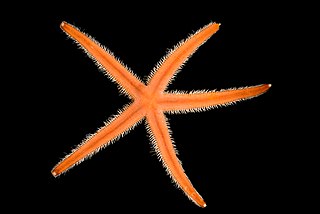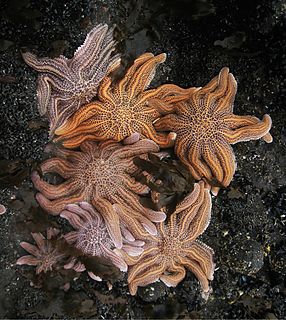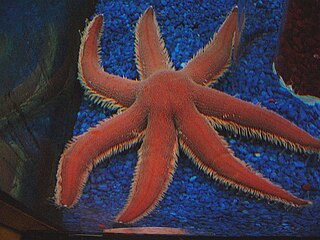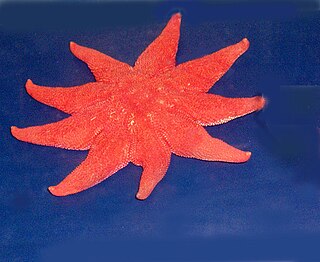
An echinoderm is any member of the phylum Echinodermata of marine animals. The adults are recognizable by their radial symmetry, and include starfish, brittle stars, sea urchins, sand dollars, and sea cucumbers, as well as the sea lilies or "stone lilies". Adult echinoderms are found on the sea bed at every ocean depth, from the intertidal zone to the abyssal zone. The phylum contains about 7,000 living species, making it the second-largest grouping of deuterostomes, after the chordates. Echinoderms are the largest phylum that has no freshwater or terrestrial members.

Crinoids are marine animals that make up the class Crinoidea, one of the classes of the phylum Echinodermata, which also includes the starfish, brittle stars, sea urchins and sea cucumbers. Those crinoids which, in their adult form, are attached to the sea bottom by a stalk are commonly called sea lilies, while the unstalked forms are called feather stars or comatulids, being members of the largest crinoid order, Comatulida.

Sea urchins are spiny, globular echinoderms in the class Echinoidea. About 950 species of sea urchin live on the seabed of every ocean and inhabit every depth zone — from the intertidal seashore down to 5,000 metres. The spherical, hard shells (tests) of sea urchins are round and spiny, ranging in diameter from 3 to 10 cm. Sea urchins move slowly, crawling with tube feet, and also propel themselves with their spines. Although algae are the primary diet, sea urchins also eat slow-moving (sessile) animals. In the food chain, the predators who eat sea urchins are the sea otter and the starfish, the wolf eel, the triggerfish, and human beings.

Starfish or sea stars are star-shaped echinoderms belonging to the class Asteroidea. Common usage frequently finds these names being also applied to ophiuroids, which are correctly referred to as brittle stars or basket stars. Starfish are also known as asteroids due to being in the class Asteroidea. About 1,900 species of starfish occur on the seabed in all the world's oceans, from warm, tropical zones to frigid, polar regions. They are found from the intertidal zone down to abyssal depths, at 6,000 m (20,000 ft) below the surface.

Sea cucumbers are echinoderms from the class Holothuroidea. They are marine animals with a leathery skin and an elongated body containing a single, branched gonad. Sea cucumbers are found on the sea floor worldwide. The number of holothurian species worldwide is about 1,717, with the greatest number being in the Asia-Pacific region. Many of these are gathered for human consumption and some species are cultivated in aquaculture systems. The harvested product is variously referred to as trepang, namako, bêche-de-mer, or balate. Sea cucumbers serve a useful role in the marine ecosystem as they help recycle nutrients, breaking down detritus and other organic matter, after which bacteria can continue the decomposition process.

The crown-of-thorns starfish, Acanthaster planci, is a large starfish that preys upon hard, or stony, coral polyps (Scleractinia). The crown-of-thorns starfish receives its name from venomous thorn-like spines that cover its upper surface, resembling the biblical crown of thorns. It is one of the largest starfish in the world.

Brittle stars, serpent stars, or ophiuroids are echinoderms in the class Ophiuroidea, closely related to starfish. They crawl across the sea floor using their flexible arms for locomotion. The ophiuroids generally have five long, slender, whip-like arms which may reach up to 60 cm (24 in) in length on the largest specimens.

Balanoglossus is an ocean-dwelling acorn worm (Enteropneusta) genus of great zoological interest because, being a Hemichordate, it is an "evolutionary link" between invertebrates and vertebrates. Balanoglossus is a deuterostome, and resembles the Ascidians or sea squirts, in that it possesses branchial openings, or "gill slits". It has a notochord in the upper part of the body and has no nerve chord. It does have a stomochord, however, which is gut chord within the collar. Their heads may be as small as per 2.5 mm (1/10 in) or as large as 5 mm (1/5 in).

A bipinnaria is the first stage in the larval development of most starfish, and is usually followed by a brachiolaria stage. Movement and feeding is accomplished by the bands of cilia. Starfish that brood their young generally lack a bipinnaria stage, with the eggs developing directly into miniature adults

Strongylocentrotus droebachiensis is commonly known as the green sea urchin because of its characteristic green color. It is commonly found in northern waters all around the world including both the Pacific and Atlantic Oceans to a northerly latitude of 81 degrees and as far south as Maine and England. The average adult size is around 50 mm (2 in), but it has been recorded at a diameter of 87 mm (3.4 in). The green sea urchin prefers to eat seaweeds but will eat other organisms. They are eaten by a variety of predators, including sea stars, crabs, large fish, mammals, birds, and humans. The species name "droebachiensis" is derived from the name of the town Drøbak in Norway.

Luidia sarsii is a species of starfish. Sand colored with a velvety texture, the species expresses pentamerism or pentaradial symmetry as adults. The five gently tapering arms have conspicuous bands of long white marginal spines in groups of three. Luidia sarsi grow to approximately 20 cm across and are found in deeper water (20 m+) from Norway to the Mediterranean but in deep colder water in the south. They are usually found on muddy sediment and are most active at night, burying themselves under the sand during the day. Luidia sarsii larva develop from a fertilized egg and are unique in a number of respects. The larva of the species attains an unusual size and a juvenile starfish develops inside the larva. During metamorphosis the juvenile migrates to the outside and detaches from the swimming larval bipinnaria stage. The larva continues to live separately for several months.

The Asterozoa are a subphylum in the phylum Echinodermata. Characteristics include a star-shaped body and radially divergent axes of symmetry. The subphylum includes the class Asteroidea, the class Ophiuroidea, and the extinct order Somasteroidea.

Eccentric sand dollar, also known as the sea-cake, biscuit-urchin, western sand dollar, or Pacific sand dollar, is a member of the order Clypeasteroida, better known as sand dollars, a species of flattened, burrowing sea urchins found in the northeast Pacific Ocean from Alaska to Baja California.

Stichaster australis, the reef starfish, is a species of starfish found in the shallow waters of the rocky intertidal of New Zealand. Typically, the animal is endemic to the west coast shores of the North and South Islands, where wave action is increased. They do not usually inhabit ecosystems that have reduced wave action and calm conditions as they prefer a higher-energy environment. These marine invertebrates range in color from pink to purple, but can also be orange. They typically have eleven arms, but sometimes they may have either ten or twelve. As full-grown adults, they are 8 to 10 cm in diameter.

Luidia ciliaris, the seven-armed sea star, is a species of sea star (starfish) in the family Luidiidae. It is found in the eastern Atlantic Ocean and the Mediterranean Sea.
Asexual reproduction in starfish takes place by fission or through autotomy of arms. In fission, the central disc breaks into two pieces and each portion then regenerates the missing parts. In autotomy, an arm is shed with part of the central disc attached, which continues to live independently as a "comet", eventually growing a new set of arms. Although almost all sea stars can regenerate their limbs, only a select few sea star species are able to reproduce in these ways.

The purple sunstar, northern sunstar, or smooth sun star, Solaster endeca, is a species of starfish in the family Solasteridae.

Acanthaster brevispinus, the short-spined crown-of-thorns starfish, is one of the two members of the starfish genus Acanthaster, along with the much better-known A. planci, the common crown-of-thorns starfish.

Luidia senegalensis, the nine-armed sea star, is a tropical species of starfish in the family Luidiidae found in the western Atlantic Ocean.

The orange knobby star, Echinaster echinophorus, is a species of sea star found in the Caribbean Sea and along the Atlantic coast of South America.



















